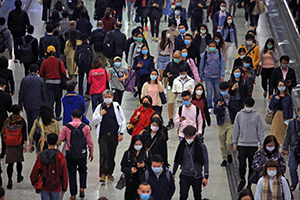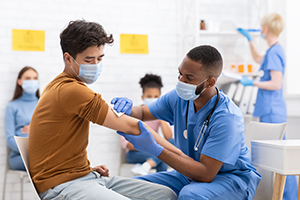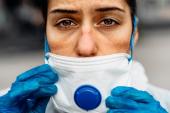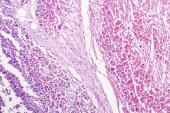COVID-19: TCTMD’s Dispatch for May Week 2
We’re curating a list of COVID-19 research and other useful content, and updating it regularly.

Since March 2020, TCTMD reporter Todd Neale has been writing up breaking news and peer-reviewed research related to COVID-19 every weekday. In July 2021, we transitioned to Mondays, Wednesdays, and Fridays. If you have something to share, tell us. All of our COVID-19 coverage can be found on our COVID-19 Hub.
May 12, 2022
Very late to a party that no one wanted to attend in the first place, North Korea has announced its first COVID-19 outbreak and national lockdown. “The danger posed by an outbreak is greater in North Korea than in most other nations because most of its people remain unvaccinated,” the New York Times observed.
 The US Congress has blocked COVID aid at a time when other countries, including Germany and Canada, are vowing to dedicate “billions” to finance tests, therapeutics, and vaccines, the NY Times reports. President Joe Biden is hosting his second virtual COVID-19 summit with Belize, Germany, Indonesia, and Senegal: he’s also ordered federal flags to fly at half-mast to mark the US COVID-19 death toll reaching 1 million.
The US Congress has blocked COVID aid at a time when other countries, including Germany and Canada, are vowing to dedicate “billions” to finance tests, therapeutics, and vaccines, the NY Times reports. President Joe Biden is hosting his second virtual COVID-19 summit with Belize, Germany, Indonesia, and Senegal: he’s also ordered federal flags to fly at half-mast to mark the US COVID-19 death toll reaching 1 million.
The European Centre for Disease Prevention and Control and the European Union Aviation Safety Agency jointly announced yesterday that masks will no longer be mandatory on flights and in airports in Europe, but specified they still “remain one of the best protections against the transmission of COVID-19.” Some countries, including Italy and Germany, have said they will keep aviation mask mandates in place while others—such as France, starting Monday—are dropping requirements.
The US Food and Drug Administration (FDA) has formally approved baricitinib (Olumiant; Eli Lilly and Company) for the treatment of COVID-19 in hospitalized adults requiring supplemental oxygen, noninvasive or invasive mechanical ventilation, or extracorporeal membrane oxygenation. The drug was first authorized under emergency use in combination with remdesivir (Veklury; Gilead Sciences) and later as a standalone agent. Olumiant, notes an agency press release, “is the first immunomodulatory treatment for COVID-19 to receive FDA approval.”
Results of the KidCOVE trial, published in the New England Journal of Medicine yesterday, suggest that two 50-μg doses of the Moderna vaccine, given 28 days apart, are effective in inducing immune responses and preventing COVID-19 in children age 6 to 11 years of age with no vaccine-related adverse events. The immune response appears similar to that seen in young adults, investigators say.
People who fall ill with COVID-19 have, for months, struggled to find Paxlovid (Pfizer) in pharmacies. Now, as STAT reports, “the bottleneck has shifted to getting a prescription—and patients and public health agencies are looking to telehealth for help.”
 Two years after a COVID-19 infection requiring hospitalization, half of more than 1,100 patients in Wuhan, China, report at least one lingering symptom, researchers write in Lancet Respiratory Medicine. “Around half of study participants had symptoms of long COVID—such as fatigue and sleep difficulties—at 2 years, and experienced poorer quality of life and ability to exercise, more mental health issues, and increased use of health-care services compared to those without symptoms of long COVID,” a press release summarizes.
Two years after a COVID-19 infection requiring hospitalization, half of more than 1,100 patients in Wuhan, China, report at least one lingering symptom, researchers write in Lancet Respiratory Medicine. “Around half of study participants had symptoms of long COVID—such as fatigue and sleep difficulties—at 2 years, and experienced poorer quality of life and ability to exercise, more mental health issues, and increased use of health-care services compared to those without symptoms of long COVID,” a press release summarizes.
An mRNA booster improves COVID-19 vaccine effectiveness following a single dose of the Janssen/Johnson & Johnson vaccine (Ad26.COV2.S), according to a US Centers for Disease Control and Prevention VISION network analysis summarized this week in JAMA. The data, from more than 80,000 emergency department or urgent care visits, indicate that a single dose of Ad26.COV2.S was only 24% effective against needing emergency or urgent medical visits, two doses were 54% effective, where as a single dose of Ad26.COV2.S followed by an mRNA booster was 79% effective. That compares with the 83% effectiveness of three consecutive mRNA vaccine doses.
A fourth dose (or second booster) of an mRNA vaccine is well-tolerated and boosts cellular and humoral immunity, regardless of the type of vaccine used for doses one, two, and three conclude investigators for the COV-BOOST trial. “Peak responses after the fourth dose were similar to, and possibly better than, peak responses after the third dose,” authors write in Lancet Infectious Diseases. “This study provides important data to help guide policy makers in decisions on how to use fourth doses of COVID-19 vaccines.” A news article in BMJ sums up the findings and implications.
A JAMA news article, meanwhile, summarizes a paper published as an early release in late March in Science Translational Medicine detailing the “subtle variations in immune responses” seen with the Moderna and Pfizer/BioNTech vaccines, concluding that “each may confer somewhat different protection.” According to the authors of the paper itself, “understanding the differences in disease attenuating, and not simply blocking antibodies, elicited by BNT162b2 and mRNA-1273 may provide new clues for the redesign of vaccines and monoclonal therapeutics able to offer a durable barrier of protection against the virus.”
In Science, Gretchen Vogel explains why the new Omicron substrains are “masters of immune evasion.” Over the past weeks, she writes, case numbers in South Africa caused by BA.4 and BA.5 jumped from roughly 1,000 per day in mid-April to nearly 10,000 by the first week of May, while a third subvariant called BA.2.12.1 is driving cases in the United States. “All three new variants have mutations that alter a key amino acid called L452, which may help explain their ability to dodge immunity,” she writes. “L452 is part of the receptor-binding domain, the part of the spike protein that locks onto cells, enabling infection. The domain is also a key target for protective antibodies.”
 The explosive growth of “preprint” publications during COVID-19 surpasses anything seen before in medical publishing and has raised some concerns that due process is being ignored. Writing in Nature Medicine, Peter Hornby, MD, PhD, argues that “rapid communication of clinical trial results has likely saved lives during the COVID-19 pandemic and should become the new norm.” A great example of this, he notes, were the RECOVERY trial’s dexamethasone results, which were announced at a press conference held—of all places—the UK Prime Minister’s home, leading to an “immediate change in care.”
The explosive growth of “preprint” publications during COVID-19 surpasses anything seen before in medical publishing and has raised some concerns that due process is being ignored. Writing in Nature Medicine, Peter Hornby, MD, PhD, argues that “rapid communication of clinical trial results has likely saved lives during the COVID-19 pandemic and should become the new norm.” A great example of this, he notes, were the RECOVERY trial’s dexamethasone results, which were announced at a press conference held—of all places—the UK Prime Minister’s home, leading to an “immediate change in care.”
May 9, 2022
White House COVID-19 Response Coordinator Ashish Jha, MD, says that the United States “may see a pretty sizable wave of infections, hospitalizations, and deaths this fall and winter." Jha made the prediction while speaking with ABC News over the weekend, adding: "Whether that happens or not is largely up to us as a country. If we can prepare and if we can act, we can prevent that."
That warning comes as US COVID-19 hospitalizations keep climbing, up nationwide by 21% these last 2 weeks, while cases have spiked by over 50%, Becker’s Hospital Review reports, and the number of US deaths has passed 1 million, according to NBC News, although other sources have offered slightly lower numbers. “While deaths from COVID have slowed in recent weeks, about 360 people have still been dying every day,” the NBC story notes.
 New proteomics research published in JACC: Basic to Translational Science is helping shed light on some of the biological mechanisms driving the heightened risk of cardiovascular complications following COVID-19 infection. The findings suggest that the senescence-associated secretory phenotype (SASP), which is a marker of biological aging, may play a key role in COVID-19 disease severity and cardiac involvement, lead author Jason Roh, MD, explained to TCTMD’s Michael O’Riordan. “It’s almost like there’s a bidirectional relationship with COVID-19 and senescence. We think part of the reason why older individuals are at higher risk of severe disease and cardiac complications is that they probably have a higher burden of senescence at baseline.”
New proteomics research published in JACC: Basic to Translational Science is helping shed light on some of the biological mechanisms driving the heightened risk of cardiovascular complications following COVID-19 infection. The findings suggest that the senescence-associated secretory phenotype (SASP), which is a marker of biological aging, may play a key role in COVID-19 disease severity and cardiac involvement, lead author Jason Roh, MD, explained to TCTMD’s Michael O’Riordan. “It’s almost like there’s a bidirectional relationship with COVID-19 and senescence. We think part of the reason why older individuals are at higher risk of severe disease and cardiac complications is that they probably have a higher burden of senescence at baseline.”
Late Friday, the US Food and Drug Administration (FDA), citing the “risk of thrombosis with thrombocytopenia syndrome,” announced that the Janssen/Johnson & Johnson vaccine should only be used in people who’ve had an anaphylactic response to an mRNA vaccine or those with “personal concerns” about this vaccine type. As of March 18, 2022, the FDA and US Centers for Disease Control and Prevention (CDC) have identified 60 confirmed cases, nine of which were fatal.
How did Hong Kong go from having one of the world’s lowest COVID-19 death rates to one of the highest, despite having easy access to vaccination? Writing in the BMJ, Rhonda Kwan notes that by late February 2022, less than half of adults over 80 had gotten their shots: “The vaccine hesitancy widespread among Hong Kong’s older population, experts say, was a result of politicizing vaccination, subsequent mixed messaging from both government and doctors, and local media’s portrayal of deaths that followed vaccination.”
 China’s strict “zero-tolerance” COVID-19 lockdown in several major cities and regions has made headlines around the globe (including a story in today’s New York Times on the shifting scenario in Taiwan and Berlin). Correspondence in the Lancet acknowledges the mental health impacts of the strategy but argues “the strategies have shown very promising results,” with the number of new cases falling from a peak of 27,719 in mid-April to 4,651 cases as of May 4, 2022, with an R0 of 9.5 (representing high transmissions) at the beginning of the wave to an effective transmission rate (Rt) of 0.67 on May.
China’s strict “zero-tolerance” COVID-19 lockdown in several major cities and regions has made headlines around the globe (including a story in today’s New York Times on the shifting scenario in Taiwan and Berlin). Correspondence in the Lancet acknowledges the mental health impacts of the strategy but argues “the strategies have shown very promising results,” with the number of new cases falling from a peak of 27,719 in mid-April to 4,651 cases as of May 4, 2022, with an R0 of 9.5 (representing high transmissions) at the beginning of the wave to an effective transmission rate (Rt) of 0.67 on May.
Omicron substrains BA.4 and BA.5 are driving big infection spikes around the world, including “crazy numbers of infections” in South Africa, a Nature News story reports. The rise of these new Omicron offshoots—including the other subvariants making waves in the US, also offer hints that new COVID-19 waves may follow more-predictable patterns, Ewen Callaway writes.
An analysis of approximately a million residents living at almost 15,000 skilled nursing facilities in the United States indicates that second booster shots offered nearly 50% greater protection against COVID-19 infection during Omicron’s reign, as compared with a single booster shot alone. “Efforts to maximize vaccination coverage, including additional primary doses, if recommended, and a booster dose, when eligible, among nursing home residents are critical,” investigators write in Morbidity and Mortality Weekly Report.
Another study, meanwhile, found that just 28% and 6% of a cohort of 82 Japanese participants had neutralizing antibodies against this strain at 2 and 7 months after two doses of the Pfizer/BioNTech vaccine, respectively. The immune response was “low in all age groups,” investigators say. “After receiving a booster vaccination, all participants acquired much higher levels of neutralizing antibodies irrespective of age,” they write in JAMA Network Open.
 The United States now recommends a second booster shot for adults over age 50, along with younger people who are immunocompromised. According to a STAT story, the FDA has already hinted that everyone will be encouraged to get second boosters this fall, something that may not be possible, given a shortage of doses. “Budget documents make it clear that if the administration does want to push second boosters, it will need more money to make it happen: it needs at least 87 million more vaccines for adult boosters, and another 5 million more for first boosters for kids.”
The United States now recommends a second booster shot for adults over age 50, along with younger people who are immunocompromised. According to a STAT story, the FDA has already hinted that everyone will be encouraged to get second boosters this fall, something that may not be possible, given a shortage of doses. “Budget documents make it clear that if the administration does want to push second boosters, it will need more money to make it happen: it needs at least 87 million more vaccines for adult boosters, and another 5 million more for first boosters for kids.”
Todd Neale is the Associate News Editor for TCTMD and a Senior Medical Journalist. He got his start in journalism at …
Read Full Bio





Comments